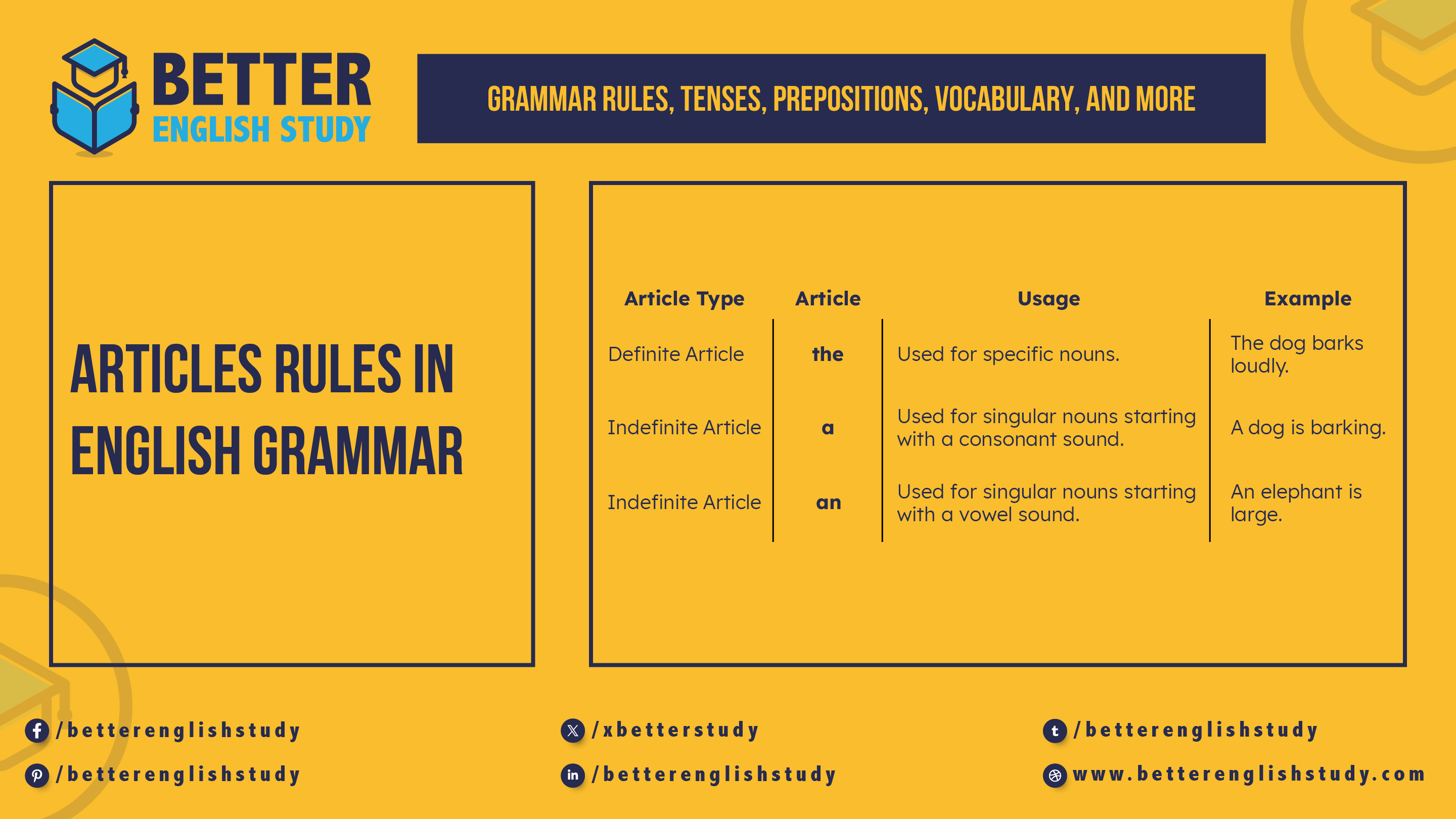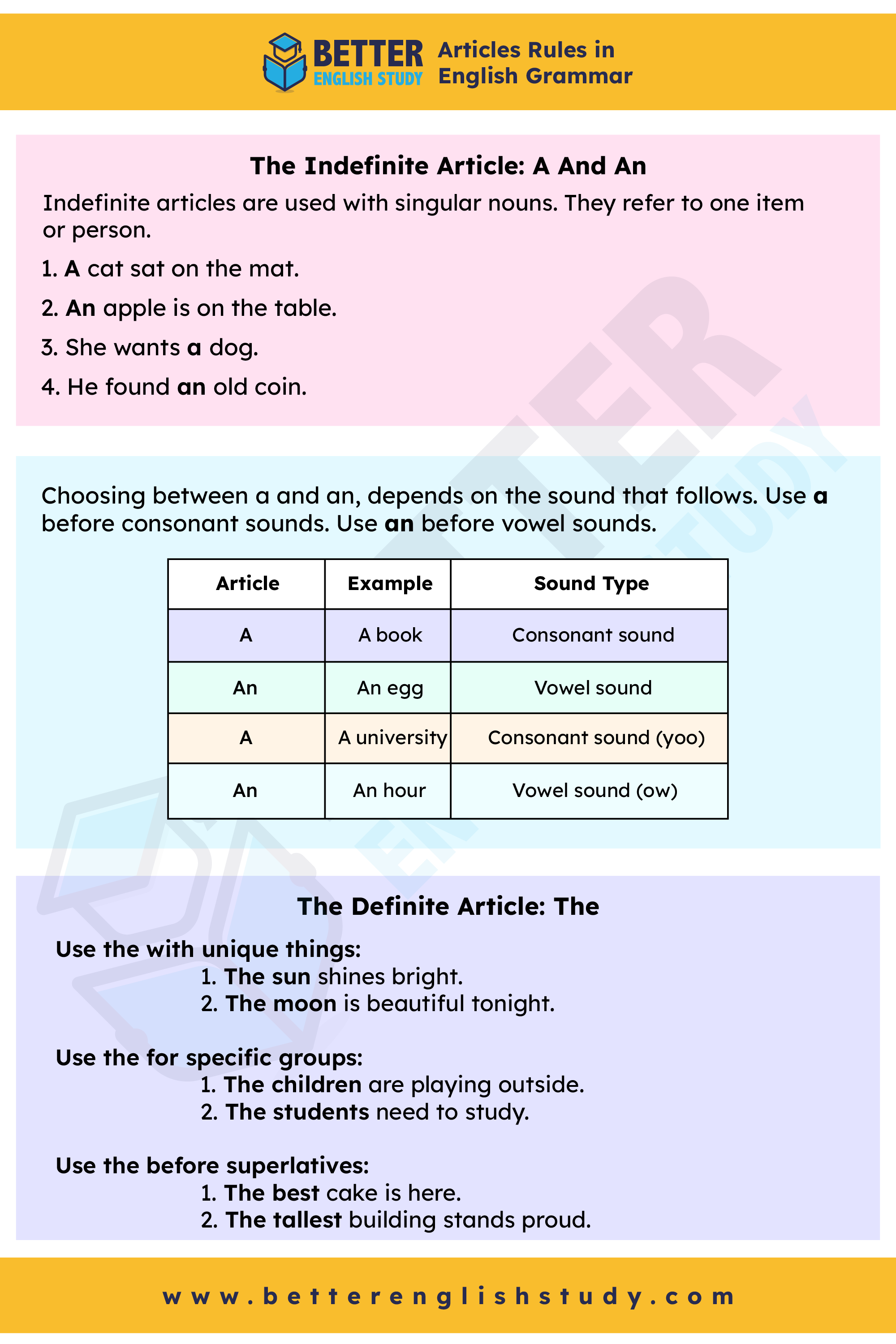
Articles in English grammar are words that define a noun as specific or unspecific. The two types of articles are definite (“the”) and indefinite (“a” or “an”).
Understanding articles is crucial for clear communication in English. They help specify whether you are talking about a particular item or any item in a category. For example, “the dog” refers to a specific dog, while “a dog” refers to any dog.
The Basics Of Articles In English Grammar
Understanding articles is key to mastering English grammar. Articles help specify nouns. There are three main articles in English: the, a, and an. Each has unique rules and uses. This section explores their definitions and types.
Defining Articles
Articles are words that define a noun as specific or unspecific.
- Definite Article: Refers to a specific noun. Example: The cat is on the roof.
- Indefinite Articles: Refers to any noun, not specific. Examples: A cat is on the roof. An apple is on the table.
Types of Articles And Their Uses
Articles can be categorized into definite and indefinite. Here’s a closer look:
| Article Type | Article | Usage | Example |
|---|---|---|---|
| Definite Article | the | Used for specific nouns. | The dog barks loudly. |
| Indefinite Article | a | Used for singular nouns starting with a consonant sound. | A dog is barking. |
| Indefinite Article | an | Used for singular nouns starting with a vowel sound. | An elephant is large. |
Here are some important points to remember:
- The is used before singular and plural nouns.
- A is used before words that sound like consonants.
- An is used before words that sound like vowels.
Knowing these basics helps improve your writing. Use articles correctly to make your sentences clear.
The Indefinite Article: A And An
The indefinite articles a and an are important in English. They introduce nouns that are not specific. Understanding when to use each is essential for clear communication.
Usage With Singular Nouns
Indefinite articles are used with singular nouns. They refer to one item or person. Here are some examples:
- A cat sat on the mat.
- An apple is on the table.
- She wants a dog.
- He found an old coin.
In these examples, the nouns are singular and not specific.
Choosing Between A And An
Choosing between a and an, depends on the sound that follows. Use a before consonant sounds. Use an before vowel sounds.
| Article | Example | Sound Type |
|---|---|---|
| A | A book | Consonant sound |
| An | An egg | Vowel sound |
| A | A university | Consonant sound (yoo) |
| An | An hour | Vowel sound (ow) |
Remember, it’s about the sound, not just the first letter.

The Definite Article: The
The word the is known as the definite article in English. It points to specific nouns. Using the helps clarify meaning. Readers know exactly what you are talking about.
General Rules
Here are the main rules for using the:
- Use the with unique things:
- The sun shines bright.
- The moon is beautiful tonight.
- Use the for specific groups:
- The children are playing outside.
- The students need to study.
- Use the before superlatives:
- The best cake is here.
- The tallest building stands proud.
Special Cases And Exceptions
Some situations require special attention:
| Situation | Example |
|---|---|
| Countries with “the” | The United States is large. |
| Oceans and rivers | The Nile is long. |
| Unique titles | The President will speak. |
Remember, not every noun needs the. For example:
- Use a or an for general nouns.
- Do not use the with plural nouns in general.
Learning these rules will improve your writing. Use the wisely to make your sentences clear.
No Article: Understanding Zero Article Usage
The concept of the zero article can be tricky. It means using no article at all. This often occurs with plural and uncountable nouns. Understanding when to use zero article helps improve your writing.
With Plural And Uncountable Nouns
Zero article is common with plural nouns and uncountable nouns. Here are the key points:
- Use zero article with general statements.
- Do not use an article before plural nouns when talking about things in general.
For example:
| Example | Explanation |
|---|---|
| Dogs | Refers to all dogs, not specific ones. |
| Water | Refers to water in general, not a specific quantity. |
Here’s a quick list of when to use zero article:
- With plural nouns for general ideas.
- With uncountable nouns for abstract concepts.
In Phrases And Fixed Expressions
Zero article appears in many common phrases and expressions. These phrases do not require articles. Here are some examples:
- Go to school.
- Play chess.
- At home.
Each of these phrases shows no article is needed. They convey clear meanings without extra words.
Understanding zero article usage helps with clarity in writing. It also makes your English sound more natural.
Geographical Use Of Articles
Understanding the geographical use of articles is essential in English grammar. Articles help specify locations and give clarity. Let’s explore how articles are used with countries, mountains, rivers, cities, and islands.
Countries
Countries often do not need articles. However, some require “the.” Here are examples:
| Country | Article |
|---|---|
| France | No article |
| The United States | Uses “the” |
| Japan | No article |
| The Netherlands | Uses “the” |
Remember, most countries do not need an article. Use “the” with countries that have plural names or specific titles.
Mountains
Mountains usually require “the.” Here are examples:
- The Himalayas
- The Rockies
- The Andes
Some mountains do not need an article, especially if they are single peaks. For instance:
- Mount Everest
- Kilimanjaro
Rivers
Rivers also generally need “the.” Here are some examples:
- The Nile
- The Amazon
- The Mississippi
Remember, use “the” for most river names. This helps identify the specific river.
Cities And Islands
Cities usually do not use articles. For example:
- London
- Tokyo
- New York
Islands often follow the same rule. For example:
- Hawaii
- Bali
- Japan
Use “the” with specific island groups. For instance:
- The Bahamas
- The Philippines
Articles With Proper Nouns
Understanding articles with proper nouns is important in English grammar. Proper nouns are specific names of people, places, or things. Articles help clarify these nouns. Let’s explore how articles work with proper nouns in different contexts.
Names Of Buildings
Buildings often have specific names. Use “the” before well-known buildings. Here are some examples:
| Building Name | Example Sentence |
|---|---|
| The Eiffel Tower | We visited the Eiffel Tower last summer. |
| The White House | They took a tour of the White House. |
| The Louvre | She admired art at the Louvre. |
Works Of Art
Art pieces often include articles. Use “the” for famous works. Here are examples:
- The Mona Lisa: A famous painting by Leonardo da Vinci.
- The Starry Night: A well-known work by Vincent van Gogh.
- The Last Supper: A masterpiece by Leonardo da Vinci.
Titles With Names
Titles often include articles. Use “the” for specific titles. Here are some examples:
- The Great Gatsby: A classic novel by F. Scott Fitzgerald.
- The Catcher in the Rye: A famous book by J.D. Salinger.
- The Lord of the Rings: A beloved series by J.R.R. Tolkien.
Proper nouns need articles for clarity. Knowing these rules helps in effective communication.
Common Mistakes And Confusions
Articles in English can be tricky. Many people make mistakes with definite and indefinite articles. Understanding these rules is essential for clear communication.
Misuse Of Articles
One common error is using the wrong article. Here are a few examples:
- Incorrect: She adopted a dog from the shelter.
- Correct: She adopted the dog from the shelter.
In this case, the dog is specific. Thus, use the instead of a.
Another common mistake involves omitting articles. For example:
- Incorrect: He plays guitar.
- Correct: He plays the guitar.
Here, the article the is needed to clarify which guitar.
Tips To Avoid Errors
Here are some useful tips:
- Identify the noun: Is it specific or general?
- Use the for unique things: For example, the sun or the Earth.
- Use a or an for non-specific items: For example, a cat or an apple.
- Practice: Read more to see how articles are used.
Remember these key points:
| Article | Usage |
|---|---|
| a | Use for any one of a kind |
| an | Use before vowel sounds |
| the | Use for something specific |
By following these tips, you can avoid common mistakes with articles.
Practice Exercises
Practice exercises enhance understanding of articles in English grammar. They help reinforce rules and build confidence. Engaging in quizzes and real-life applications deepens knowledge.
Quizzes
Quizzes are fun and effective for learning articles. Test your skills with the following questions:
| Question | Your Answer | Correct Answer |
|---|---|---|
| ___ apple a day keeps the doctor away. | a | |
| She wants to be ___ artist. | an | |
| Can you pass me ___ salt? | the | |
| He is ___ tallest boy in the class. | the |
Check your answers and see how many you got right!
Real-life Application Tips
Applying articles in daily life makes learning easier. Here are tips to use articles correctly:
- Read books: Pay attention to articles.
- Write sentences: Use articles in your writing.
- Speak often: Practice using articles in conversations.
- Listen carefully: Notice how others use articles.
Consider these example sentences:
- I saw a dog in the park.
- She is an engineer.
- We visited the museum yesterday.
- It was the best day ever!
Using articles correctly helps improve your English skills. Keep practicing!
Frequently Asked Questions
What Are Articles In English Grammar?
Articles are words used before nouns to define them. There are two types: definite and indefinite. The definite article “the” specifies a particular noun. Indefinite articles “a” and “an” refer to non-specific nouns. Understanding articles helps in constructing clear and accurate sentences.
When To Use ‘a’ Or ‘an’?
Use “a” before consonant sounds and “an” before vowel sounds. For example, “a cat” and “an apple. ” The sound, not the letter, determines which article to use. Mastering this rule enhances fluency and clarity in your writing.
What Is The Difference Between Definite And Indefinite Articles?
The definite article “the” refers to a specific noun. Indefinite articles “a” and “an” refer to any member of a group. For instance, “the book” indicates a particular book, while “a book” refers to any book. Knowing this distinction improves sentence precision.
Can Articles Be Omitted In Sentences?
Yes, articles can be omitted in certain contexts. This often occurs with plural nouns or uncountable nouns. For example, “I love music” omits “the. ” Omitting articles can make sentences more concise, but it’s essential to use them correctly for clarity.
Conclusion
Mastering article rules in English grammar is essential for clear communication. By understanding the difference between “a,” “an,” and “the,” you can enhance your writing significantly. Remember to practice with various examples. This knowledge will improve your confidence and make your writing more effective.
Keep exploring and learning to refine your skills.
